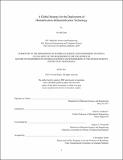| dc.contributor.advisor | John H. Lienhard V and Eugene A. Fitzgerald. | en_US |
| dc.contributor.author | Chari, Arvind | en_US |
| dc.contributor.other | Massachusetts Institute of Technology. Dept. of Materials Science and Engineering. | en_US |
| dc.date.accessioned | 2012-03-16T14:41:55Z | |
| dc.date.available | 2012-03-16T14:41:55Z | |
| dc.date.copyright | 2011 | en_US |
| dc.date.issued | 2011 | en_US |
| dc.identifier.uri | http://hdl.handle.net/1721.1/69664 | |
| dc.description | Thesis (M. Eng.)--Massachusetts Institute of Technology, Dept. of Materials Science and Engineering, 2011. | en_US |
| dc.description | This electronic version was submitted by the student author. The certified thesis is available in the Institute Archives and Special Collections. | en_US |
| dc.description | Cataloged from PDF version of thesis. | en_US |
| dc.description | Includes bibliographical references (p. 88-95). | en_US |
| dc.description.abstract | The world is suffering from a severe shortage of potable water. This effect is most noticeable in third-world regions, specifically in rural Africa and Asia. In these regions, clean water exhaustion has resulted in a myriad of negative affects such as diarrhea, infant death syndrome, hepatitis, and malaria. These sicknesses continue to take a serious economic and humanitarian toll on communities. By reducing the resources spent on these needless water related medical expenditures, clean water acts as an enabling good, alleviating poverty and increasing rural wellbeing. HDH technology, which has been compared against competing technologies in the field, has several advantages over other desalination technologies when providing this good to rural markets. While the installed material cost of HDH has been approximated to be about ten times greater than optimized competitors such as reverse osmosis, HDH has virtually no maintenance cost or complexity, it scales reliably to low generating capacities, and it uses abundant solar heat instead of often unavailable electrical sources. Furthermore, the detailed market analysis in this paper shows that there are clearly markets which are ripe for HDH adoption, specifically the district of South 24 Parganas in West Bengal. Finally, multiple successful case studies have been investigated to compose an implementation plan, through which millions of dollars in profit are realistically realizable. Overall, HDH technology has key advantages which should help it towards successful commercialization. | en_US |
| dc.description.statementofresponsibility | by Arvind Chari. | en_US |
| dc.format.extent | 95 p. | en_US |
| dc.language.iso | eng | en_US |
| dc.publisher | Massachusetts Institute of Technology | en_US |
| dc.rights | M.I.T. theses are protected by
copyright. They may be viewed from this source for any purpose, but
reproduction or distribution in any format is prohibited without written
permission. See provided URL for inquiries about permission. | en_US |
| dc.rights.uri | http://dspace.mit.edu/handle/1721.1/7582 | en_US |
| dc.subject | Materials Science and Engineering. | en_US |
| dc.title | A global strategy for the deployment of humidification-dehumidification technology | en_US |
| dc.type | Thesis | en_US |
| dc.description.degree | M.Eng. | en_US |
| dc.contributor.department | Massachusetts Institute of Technology. Department of Materials Science and Engineering | |
| dc.identifier.oclc | 777363794 | en_US |
